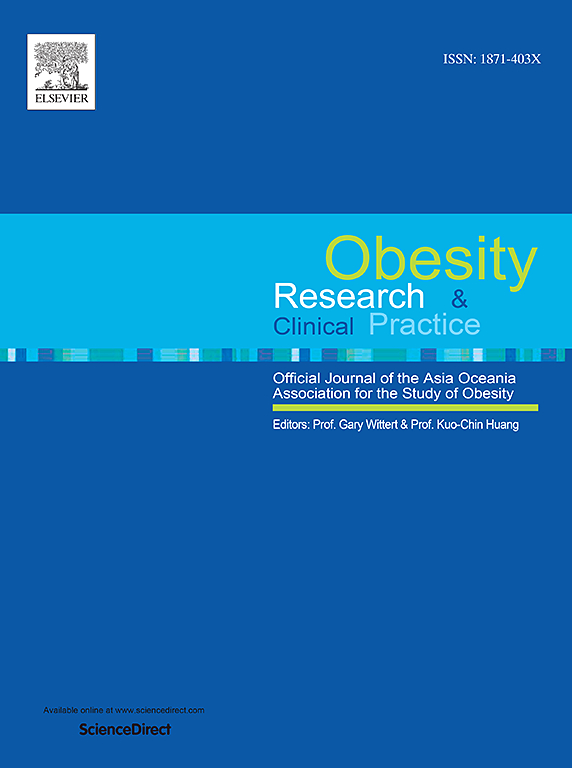Effects of obesity on function, pain, and complications after rotator cuff repair: An updated systematic review and meta-analysis
IF 2.5
4区 医学
Q3 ENDOCRINOLOGY & METABOLISM
引用次数: 0
Abstract
This meta-analysis aimed to determine the impact of obesity on function, pain, complication and patient-reported outcome measure following rotator cuff repair. This meta-analysis compares patients with obesity and without obesity undergoing rotator cuff repair surgery in terms of effectiveness, safety, and patient-reported measures. Four major databases were searched. Odds ratios, mean differences, and standard mean differences with 95 % confidence intervals (CIs) were calculated. The meta-analysis was performed using Review Manager version 5.4. Sixteen studies (n = 139,638 patients) were included. At the final follow-up, patients with obesity had significantly higher visual analogue scale (VAS) pain (SMD 0.16, 95 % CI 0.03–0.29). Patients with obesity had lower American Shoulder and Elbow Surgeons Shoulder Score (ASES) scores (MD −4.70, 95 % CI −7.57 to −1.82). No differences were observed in range of motion (ROM). Patients with obesity had a higher overall complication risk (OR 1.64, 95 % CI 1.38–1.95; I2 = 19 %) driven by obesity (OR 1.66, 95 % CI 1.29–2.13) and severely subgroups with obesity (OR 1.84, 95 %CI 1.43–2.37). Patients with obesity had significantly higher risks of thrombosis, myocardial infarction, cardiac arrest and renal complications. They also showed significantly higher reoperation (OR 1.31, 95 % CI 1.21–1.43) and readmission rates (OR 1.37, 95 % CI 1.31–1.44). Obesity is associated with worse pain and function and higher complication rates after rotator cuff repair. These findings have implications for perioperative counseling and management in this population.
肥胖对肩袖修复后功能、疼痛和并发症的影响:一项最新的系统综述和荟萃分析。
本荟萃分析旨在确定肥胖对肩袖修复后功能、疼痛、并发症和患者报告的结果测量的影响。本荟萃分析比较了接受肩袖修复手术的肥胖和非肥胖患者的有效性、安全性和患者报告的措施。检索了四个主要数据库。计算比值比、平均差异和标准平均差异,95% %置信区间(ci)。meta分析使用Review Manager版本5.4进行。纳入16项研究(n = 139,638例患者)。在最后随访时,肥胖患者的视觉模拟评分(VAS)疼痛明显更高(SMD 0.16, 95 % CI 0.03-0.29)。肥胖患者的American Shoulder and Elbow Surgeons Shoulder Score (ASES)评分较低(MD -4.70, 95 % CI -7.57 ~ -1.82)。在活动范围(ROM)方面没有观察到差异。肥胖患者的总并发症风险更高(OR 1.64, 95 % CI 1.38-1.95;I2 = 19 %)由肥胖驱动(OR 1.66, 95 %CI 1.29-2.13)和严重肥胖亚组(OR 1.84, 95 %CI 1.43-2.37)。肥胖患者血栓形成、心肌梗死、心脏骤停和肾脏并发症的风险明显增加。再手术率(OR 1.31, 95 % CI 1.21-1.43)和再入院率(OR 1.37, 95 % CI 1.31-1.44)均显著高于对照组。肥胖与肩袖修复术后更严重的疼痛和功能以及更高的并发症发生率有关。这些发现对该人群的围手术期咨询和管理具有启示意义。
本文章由计算机程序翻译,如有差异,请以英文原文为准。
求助全文
约1分钟内获得全文
求助全文
来源期刊

Obesity research & clinical practice
医学-内分泌学与代谢
CiteScore
7.10
自引率
0.00%
发文量
80
审稿时长
49 days
期刊介绍:
The aim of Obesity Research & Clinical Practice (ORCP) is to publish high quality clinical and basic research relating to the epidemiology, mechanism, complications and treatment of obesity and the complication of obesity. Studies relating to the Asia Oceania region are particularly welcome, given the increasing burden of obesity in Asia Pacific, compounded by specific regional population-based and genetic issues, and the devastating personal and economic consequences. The journal aims to expose health care practitioners, clinical researchers, basic scientists, epidemiologists, and public health officials in the region to all areas of obesity research and practice. In addition to original research the ORCP publishes reviews, patient reports, short communications, and letters to the editor (including comments on published papers). The proceedings and abstracts of the Annual Meeting of the Asia Oceania Association for the Study of Obesity is published as a supplement each year.
 求助内容:
求助内容: 应助结果提醒方式:
应助结果提醒方式:


